Mid-season carrot variety Samson
Samson is one of the most popular varieties carrots. This is due to the taste and presentation of root crops, good keeping quality and abundant yield, independent of weather conditions. The variety is resistant to diseases and pests and does not require special care.
Description of the variety
This table carrot variety is characterized by large root vegetables with a small core and juicy sweet pulp with a high carotene content.
The Samson carrot was bred by Dutch breeders from the Bejo Zaden company. The variety was included in the State Register of Russia in 2001.
Composition and beneficial properties
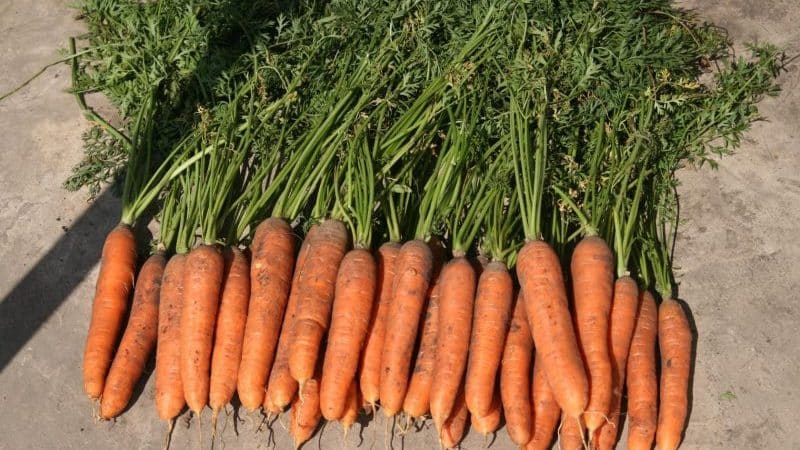
100 g of Samson carrots contains:
- 10.6% dry matter;
- 11.6 mg of carotene (provitamin A);
- 7.6% sugar;
- vitamins C, K, E, PP, group B;
- potassium, magnesium, phosphorus, calcium, sodium, iron, iodine, zinc and fluorine.
Carrots help eliminate toxins, strengthen the immune system, improve the functioning of the gastrointestinal tract and skin condition, and have a positive effect on the cardiovascular system, kidneys and liver.
Features of application
Root vegetables are consumed fresh, added to snacks and hot dishes, sauerkraut, conservation for the winter. Carrots are suitable for processing, making juices and purees.
Ripening period
Samson is a mid-season variety. From the appearance of full shoots to the onset of technical maturity of vegetables, 110–120 days pass.
Resistance to diseases and pests
Samson is resistant to most diseases characteristic of vegetable crops of the Apiaceae family.In rare cases, plantings are attacked by carrot flies, especially when crop rotation rules are violated.
Characteristics and productivity of the variety
This is a powerful plant with a semi-spreading rosette of leaves. The leaves are long, rich green in color, with medium dissection and slight pubescence.
The root crops are cylindrical in shape with a slightly pointed end, large - each reaches 18–30 cm in length, 4–5 cm in diameter and weighs 120–150 g.
Ripe carrots are bright orange in color. The core is slightly lighter, makes up no more than 25% of the total diameter and fits tightly to the pulp. Taste juicy, sweetish.
The productivity of the variety depends on the composition of the soil, the climatic conditions of the region and compliance with agrotechnical requirements. On average, 5.5–8.5 kg of vegetables are harvested from 1 m2. Marketable yield is 528–762 c/ha.
What regions is it suitable for?
The variety is included in the State Register for the Central region. At the same time, Samson is unpretentious to soil and climatic conditions and is successfully cultivated in all regions of Russia, Belarus and Ukraine.
Advantages and disadvantages
The main advantages of the variety:
- high seed germination (up to 80%);
- frost resistance;
- attractive presentation of root crops;
- long shelf life;
- high productivity;
- immunity to most diseases;
- almost complete absence of damaged or deformed vegetables;
- ease of care.
The disadvantages are minimal - the high cost of seeds and the problem of acquiring them due to their popularity.
Differences from other varieties
The main differences between Samson and other popular carrot varieties are presented in the table:
| Variety | Ripening period | Productivity, kg/m2 | Carotene content, mg | Weight of root vegetables, g |
| Samson | 110–120 days | 5,5–8,5 | 11,6 | 120–150 |
| Vitamin | 93–120 days | 4–10 | 17–22 | 61–164 |
| Boltex | 100–125 days | 8–10 | 11,7 | 100–160 |
| Chance | 65–100 days | 5–7 | 10–13 | 100–170 |
Features of planting and growing
Growing this unpretentious crop does not require much effort. It is only important to follow the rules of crop rotation, site selection and seed preparation.
Preparing for landing
Types of Samson seeds:
- calibrated - characterized by increased germination;
- in granules - covered with a nutritious coating;
- treated with fungicides - protected from diseases and fungi.
Gardeners often soak planting material, but it is important to first read the recommendations on the packaging: this procedure harms granulated seeds and seeds treated with fungicidal preparations.
They begin preparing the area for planting carrots in the fall: they dig up the soil, clear it of weeds and feed it with organic fertilizers (5 kg of compost or humus per 1 m2). In this case, in the spring they only dig up the ground again.
Soil requirements
Although Samson does not have any special requirements for soil composition, it is better to grow it in fertile, light soil with medium or neutral acidity and good moisture and air permeability. Loams and sandstones are suitable.
Reference. Heavy soil is supplemented with sand or sawdust and thoroughly loosened, and chalk, lime or dolomite flour is used to deoxidize the soil.
Predecessors
The best predecessors of carrots are onions, potatoes, cabbage, zucchini, cucumbers and pumpkin.
Do not plant Samson seeds in an area where beets or other varieties of carrots previously grew. If this is not possible, the ground is carefully dug up.
Landing dates and rules
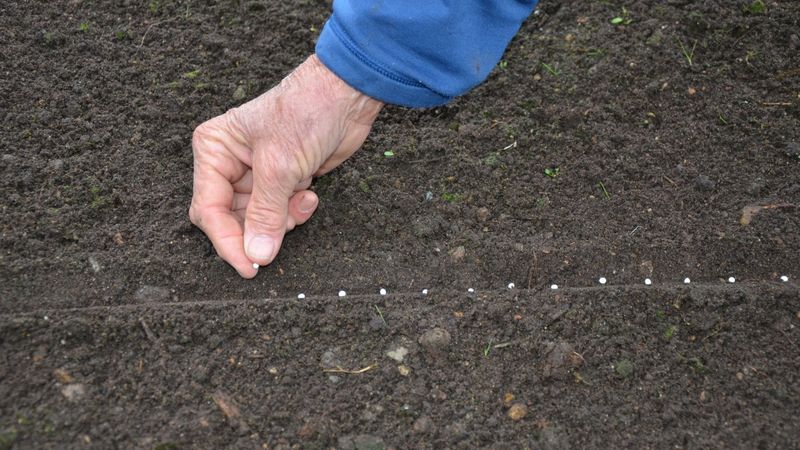
Seeds planted in spring, in mid-April - early May, or in autumn, in October - November. During spring planting, the air temperature should be +14...+17°C, and the soil temperature - +5...+9°C.In autumn, they wait until the first frosts on the soil and the average daily temperature drops to +5°C.
Planting pattern:
- Prepare the beds at a distance of 20–25 cm from each other.
- Make indentations in them every 2-3 cm.
- Water the soil a few hours before sowing.
- Place the seeds in the prepared holes, deepening them to a maximum of 2 cm.
- Sprinkle with soil and cover with non-woven material if cold weather is expected.
In autumn, it is allowed to sow in slightly frozen furrows, which are then sprinkled with a peat mixture or humus.
Features of cultivation
The main subtleties of Samson's cultivation:
- for planting, choose a well-lit place on a hill, since carrots do not develop well in the shade and lowlands;
- Onions are planted nearby, which repel the carrot fly.
Nuances of care
The variety does not require specific care. To obtain a high-quality and abundant harvest, it is enough to follow the standard rules and norms of agricultural technology.
Watering mode
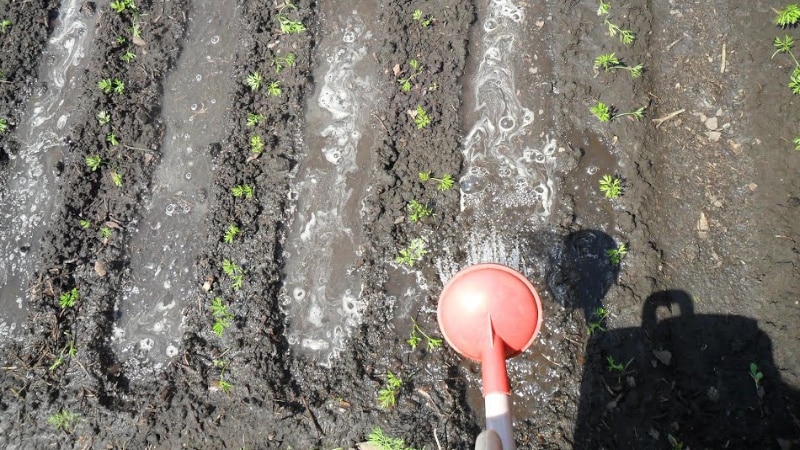
Plants need regular and abundant watering: drying out of the soil negatively affects the taste and presentation of root crops.
For 3 weeks after sowing and during dry periods, carrots are watered daily, under favorable weather conditions - once every 2-3 days. Approximately 2-3 weeks before harvesting, irrigation is stopped, otherwise the vegetables will not be stored well and will begin to crack.
To retain moisture in the soil, the beds are mulched with straw, plant debris or sawdust. To prevent the appearance of a crust on the surface of the soil, it is loosened after each watering.
Important! Water for irrigation is used that is settled and warm.
Thinning and weed control
The beds are weeded in a timely manner, because...fast-growing weeds slow down the development of carrots, depriving them of nutrients, and can displace the crop from the site.
Thinning is carried out at least twice:
- 3 weeks after the appearance of the first shoots;
- when the vegetables reach a diameter of 2 cm.
The distance between plants is left 5–7 cm so that the root crops do not become deformed or stretched.
Important! Thinning is not carried out when planting carrots in strips.
Top dressing
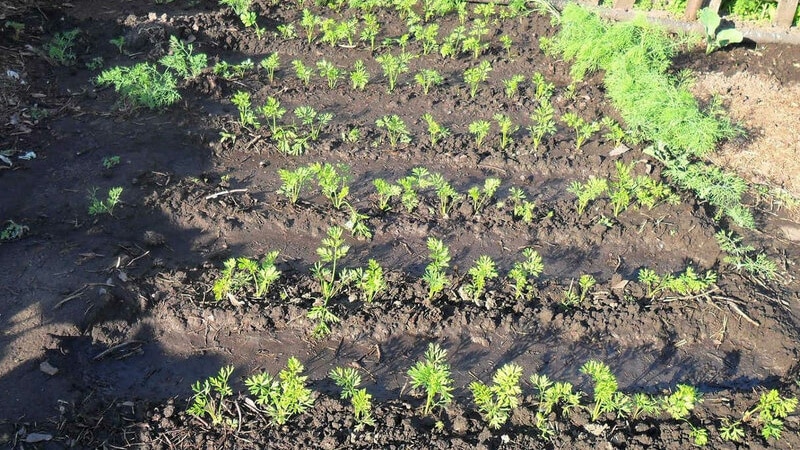
Fertilize the plantings 3-4 times during the growing season with mineral fertilizers aimed at the development of root crops. Organic fertilizers stimulate the growth of green mass and provoke branching and deformation of vegetables.
In June, nitrogen-containing compounds are applied, then only potassium fertilizers are used. The last time the crop is fertilized is 4 weeks before harvest.
Attention! An excess of nitrogen leads to the development of phomosis.
Disease and pest control
Despite the high immunity of the variety, prevention is observed. To minimize the risk of pest attacks, traditional methods are used:
- spraying with a mixture of wormwood and wood ash;
- dusting with tobacco, hot pepper or mustard.
To prevent the development of black rot, plants are treated with Bordeaux mixture or Falcon and Prosaro preparations.
Difficulties in growing
When cultivating Samson, the following problems arise:
- development of Phoma with excessive use of nitrogen fertilizers;
- deformation of root crops due to dense planting of seeds;
- rotting of vegetables due to excessive watering and waterlogging of the soil.
Harvest and storage
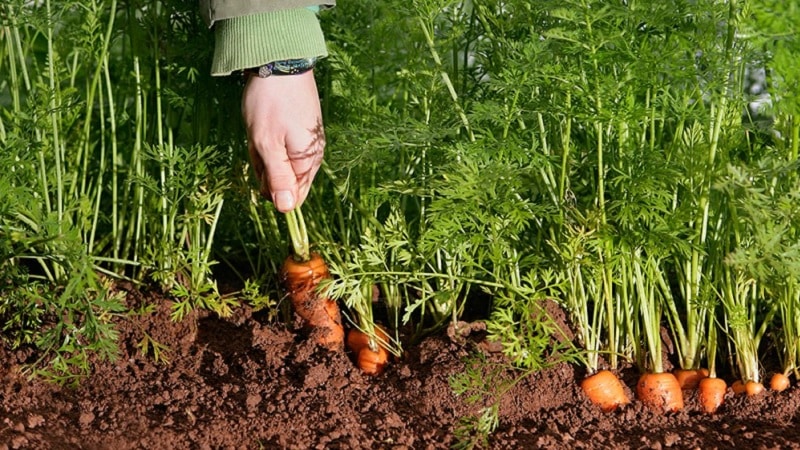
It is important to correctly determine the harvest time: carrots dug up too early will not have time to gain sweetness and juiciness, and late harvesting of root crops will lead to cracking and spoilage.
How and when to collect
The first harvest is dug up in July; carrots reach full maturity in August. The timing depends on the time of planting and climatic conditions.
By the way! Vegetables, even after full ripening, do not protrude above the surface of the ground, so the head does not turn green.
Harvesting work is carried out in dry and sunny weather. The harvest is removed with a shovel or a pitchfork: the plants are carefully dug up and pulled out of the ground by the tops.
Storage features and keeping quality of the variety
The tops are cut off from the dug carrots, the root crops are dried and carefully inspected, removing damaged or rotten specimens.
For storage, carrots are placed in open plastic bags or boxes with slightly moistened sand and taken out to a dry, dark room with an air humidity of 85% and a temperature of 0…+3°C.
Under optimal conditions, carrots can be stored for 8-9 months. The variety has good shelf life: after six months, 86.7% of root crops do not lose their taste and commercial quality.
Advice from experienced gardeners
Farmers' recommendations for cultivating Samson:
- When planting, seeds are not buried too deep so as not to delay the emergence of seedlings or reduce their number.
- They mainly use mineral fertilizers; the use of organic matter is permissible only in the fall, when preparing the site for spring planting.
- Seedlings are regularly thinned out, otherwise the root crops will become deformed.
Reviews
Most gardeners fell in love with the Samson variety, which is confirmed by positive reviews. However, there are those who do not like carrots.
Sergey, Samara: “We have been growing Samson carrots for a long time, we are satisfied with its characteristics. The harvest is plentiful, ripens early, almost all root crops are even and beautiful. We store the harvest in wooden boxes, sprinkled with sand.”
Marina, Tula region.: “The neighbor really praised this variety, and it looks gorgeous in the photo - I decided not to lag behind and planted it too. And I was disappointed. The seeds are expensive, and I didn’t like the taste of the vegetables: there is little sweetness, the core is hard, and even dry. The harvest is rich, of course, but that’s not the main thing for me.”
Conclusion
Samson is a mid-season table carrot variety that is successfully cultivated in all regions of Russia. It is highly resistant to diseases, does not require specific care, and if simple agrotechnical rules are followed, it produces a bountiful harvest of tasty and juicy root crops.